24 inches wide, 9 inches deep, 20 feet long, custom everything.
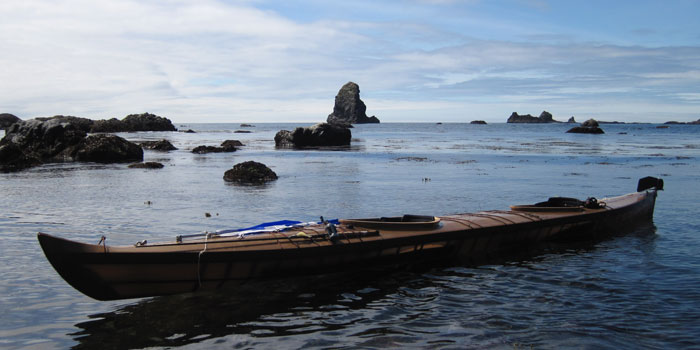
I like doubles, a lot of people don't. While it's true that a double removes some of the freedom and spryness of traveling in singles, it also adds efficiency for straight line travel and can be a great way to even out the difference between paddlers of different strength and skill levels. I appreciate the camraderie of being in the same boat. What I don't like about doubles is that they usually weigh over a hundred pounds, cost a small fortune, and generally tend to be built a bit wide for my stroke preference.
In early June my friend Leann and I got the idea that we should go on a trip in a double, with the small concern that first I had to design one. We sat down with a pen and some scratch paper one afternoon and drew up a reasonable looking boat. The idea was to stick with the basic geometry and ergonomics of the F1 with a similar misson as well, a quick lightweight manuverble kayak intended for maximum fun with minimal effort, on day trips and tours up to one week long.
Three days later we had the frame built, tweaking every aspect to fit our bodies while leaving enough wiggle room for other paddlers to check it out as well. I skinned it during a class and spent a day bolting on sails and hardware. It was a lot of fun customizing the kayak to meet our specific needs and in the end I think that with all the expensive hardware I might have violated the simple ethic of skin-on-frame just a bit. I think the soul of this boat wants to be a stripped down lightweight version, 45lbs and perfect for throwing on the car for a weekend paddle, but just like any boat, there is little limit to the amount of stuff you can add to it.
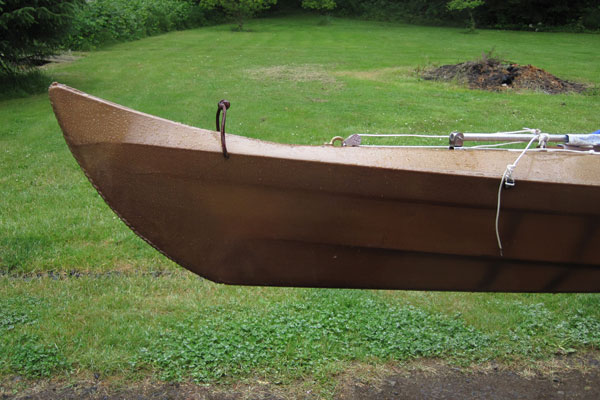
The bow swoop on the F2 is anything but cosmetic. With the weight of two paddlers spaced apart, even the broad bouyant bow of the F1 needs a little help to rise through a breaking wave. The goal here is to split the water and break the surface tension to keep green water from pinning down the bow when breaking through the surf.
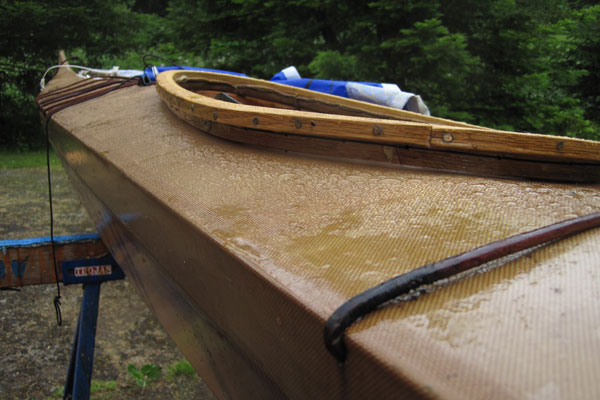
With the back of the bow coaming raised, I needed to re-steam the entire cockpit into a taco shape to drop the sides for a little extra comfort for the paddler in the bow.

The cockpits are spaced just far enough apart to allow for aggressive paddling without clacking paddles, but close enough together to let paddlers pass things back and forth. The heavily reinforced and nearly flat deck in the middle makes and excellent work surface for stowing crab traps, filleting fish, reading charts, stacking gear, or whatever. As always, deck lines are hard oil tanned latigo, strong enough to lift the loaded kayak by, and won't let items fly off in the surf like a criss cross of bungees does.

Back support is the same as in the F1, these Snap Dragon bands are tough, comfortable, and simple.
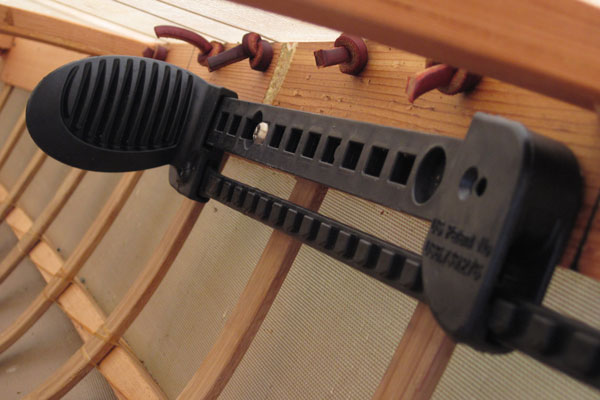
Also the same as the F1 are the wilderness systems slidelock footbraces, easy to adjust on the fly, which makes a big difference in comfort when you are on the water for hours on end.

For the rear cockpit I chose Sea Dog pedals instead. These burly pedals allow for hard bracing while still offering fine rudder control and are light years better than a sliding track system, and much more robust than the seal line toe pedals. They also adjust without making cable adjusments.
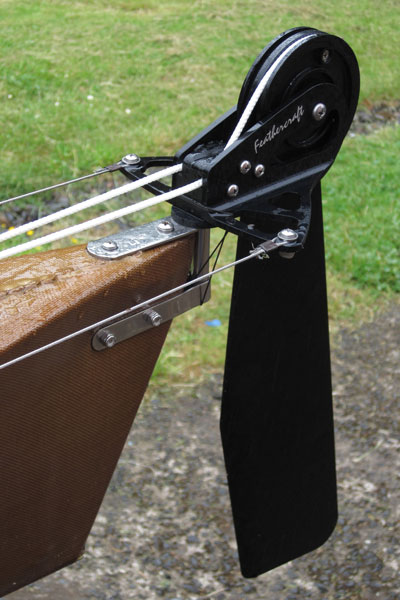
I bought this Feathercraft rudder and bracket from Chesapeke Light Craft.
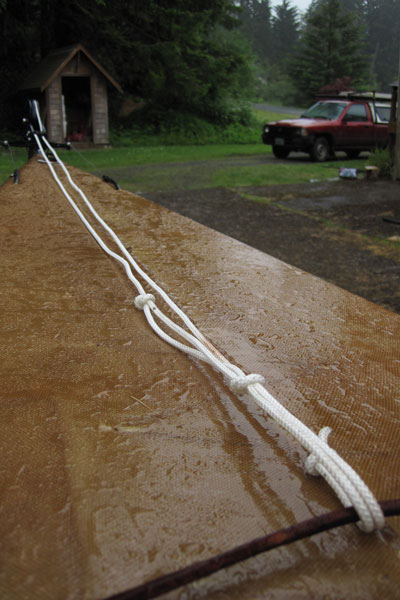
Where low tech meets high tech. Instead of a double cleat and bungee system for the rudder deployment, I found that a simple rope tied in a loop around a deck line was much easier to use. The weight of the rudder kept it in place up or down, and it kicked up automatically, simple.
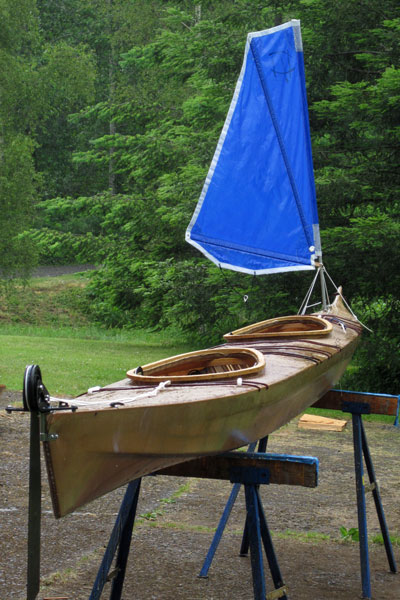
I added this sail from Flat Earth Kayak Sails for a bit of extra push on downwind or reaching courses.

All the strings and hardware can seem a bit intimidating, but in practice the stays did not get in the way or foul, and the system worked flawlessly despite it's complex appearance.
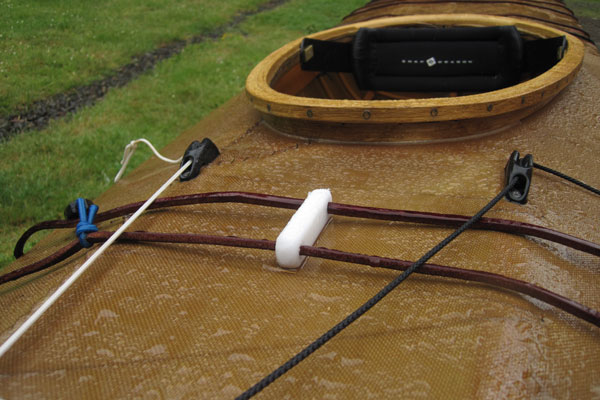
The white rope is the halyard and the black one the sheet. A small bungee collects the sail and mast neatly when stowed on deck. There are many kayak sail systems including an ingenious one now in production in Tasmania that actually provides windward performance but requires a rudder. You could go either way on a double but for a rudderless single this system is good choice. As always sails increase the risk of capsize so extra attentiveness and a cautious approach is advised.
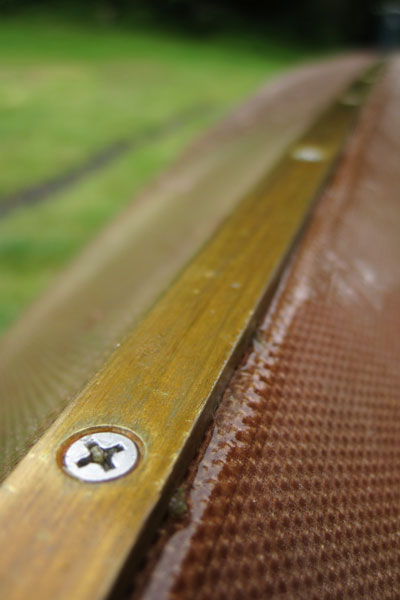
A very smart feature for a hard working double is this 1/2 x 1/8 inch solid brass strip that I used to protect the entire length of the keel. I'm not sure I'd bother for a day tripper or occasional camper, but when intended to drag up and down rocky beaches with a heavy load, this strip can, and did, take a lot of abuse.

Often times I'll build over a dozen prototypes before becoming disgusted with a design and finally giving up, so it is a real pleasure to build something that turned out so well on the first try. It's no coincidence that the heart of this boat, or rather, the bow and stern are taken almost stock from the F1. In fact, this is nothing more than an F1 with six feet added in the center. It retains many of the F1's handling characteristics, even without the rudder.
We took it out through the surf once and had a riotously good time surfing it in! and I'm sure that given my proclivity for such activities there will be more surf photos appearing here soon! For the real maiden voyage Leann and I took a four day trip down Northwest Washington's wild Ozette coast which was one of the best sea kayaking trips I've taken! I'm looking forward to future adventures in the F2 and using it to troll for salmon offshore.
It would be fun to build them in classes as well but I'm not quite sure how to price things. The double is nearly twice the expense and twice the effort of two singles when you consider the neccessary customizations. I imagine we'll work out the cost on a case by case basis until a few more get built.
Back to Cape Falcon Kayak